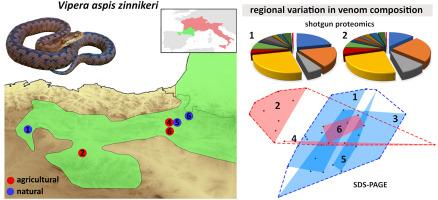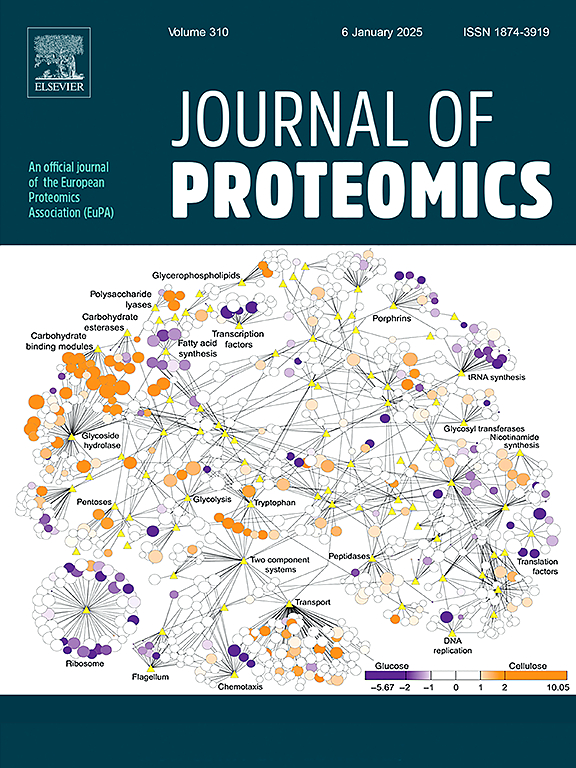Intraspecific venom variation in the Iberian asp viper (Vipera aspis zinnikeri) across natural and intensive agricultural habitats
IF 2.8
2区 生物学
Q2 BIOCHEMICAL RESEARCH METHODS
引用次数: 0
Abstract
Snake venom composition varies at different levels. To date, comparative venom studies have seldom taken into account the role of habitat type in the occurrence of snake venom variation. Here we investigated the presence of venom variation across different populations of the Iberian asp viper (Vipera aspis zinnikeri) inhabiting two contrasting habitats: natural vs. intensive agricultural. We used shotgun proteomics to describe the protein composition of the venoms of six adults from two distinct localities. Furthermore, to test whether local conditions and habitat can alter venom composition in this taxon, we compared the SDS-PAGE profiles of 40 adult venoms from six populations, three in natural habitats and three in intensive agricultural environments. The venoms were composed of 21 toxin families, of which five (CTL, PLA2, VEGF, svSP, and svMP) comprised 69–82 % of each proteome. The relative abundances of toxin families varied considerably at inter- and intra-population levels. Linear regression performed on non-metric multidimensional scaling values showed a significant effect of locality of origin and habitat type on the differences detected between individual SDS-PAGE venom profiles. Our results suggest the presence of regional variation in V. a. zinnikeri venom, potentially reinforcing the role of local pressures in shaping snake venom composition.
Significance
This work provides the first proteomic characterization of the venom of the Iberian asp viper, Vipera aspis zinnikeri, obtained by means of shotgun proteomics. The statistical analysis of 40 individual SDS-PAGE venom profiles highlights that venom variation in this taxon can be associated with geographical origin and habitat type of the area where each viper was collected. Our results suggest the presence of regional variation in V. a. zinnikeri venom, reinforcing the role that local pressures may play as drivers of snake venom variation.

伊比利亚蝰蛇(Vipera aspis zinnikeri)在自然栖息地和集约化农业栖息地的种内毒液变异。
蛇毒成分在不同层次上存在差异。迄今为止,毒液比较研究很少考虑栖息地类型在蛇毒变异中的作用。在这里,我们研究了伊比利亚蝰蛇(Vipera aspis zinnikeri)在两种截然不同的栖息地(自然栖息地和集约化农业栖息地)中不同种群的毒液变异情况。我们使用霰弹枪蛋白质组学描述了来自两个不同地区的六条成年蝰蛇毒液的蛋白质组成。此外,为了检验当地条件和栖息地是否会改变该类群的毒液组成,我们比较了来自六个种群(三个在自然栖息地,三个在集约农业环境)的 40 个成体毒液的 SDS-PAGE 图谱。这些毒液由 21 个毒素家族组成,其中 5 个毒素家族(CTL、PLA2、VEGF、svSP 和 svMP)占每个蛋白质组的 69-82%。毒素家族的相对丰度在种群间和种群内差异很大。对非度量多维缩放值进行的线性回归表明,原产地和栖息地类型对个体 SDS-PAGE 毒液图谱之间的差异有显著影响。我们的研究结果表明,V. a. zinnikeri 毒液存在区域差异,这可能加强了当地压力在塑造蛇毒成分方面的作用。意义:这项研究首次通过霰弹枪蛋白质组学方法对伊比利亚蝰蛇(Vipera aspis zinnikeri)的毒液进行了蛋白质组学表征。对 40 个 SDS-PAGE 毒液图谱的统计分析结果表明,该类群的毒液差异与地理起源和每条蝰蛇采集地的栖息地类型有关。我们的研究结果表明,V. a. zinnikeri 毒液存在区域性差异,这进一步证实了地方压力可能是蛇毒变异的驱动因素。
本文章由计算机程序翻译,如有差异,请以英文原文为准。
求助全文
约1分钟内获得全文
求助全文
来源期刊

Journal of proteomics
生物-生化研究方法
CiteScore
7.10
自引率
3.00%
发文量
227
审稿时长
73 days
期刊介绍:
Journal of Proteomics is aimed at protein scientists and analytical chemists in the field of proteomics, biomarker discovery, protein analytics, plant proteomics, microbial and animal proteomics, human studies, tissue imaging by mass spectrometry, non-conventional and non-model organism proteomics, and protein bioinformatics. The journal welcomes papers in new and upcoming areas such as metabolomics, genomics, systems biology, toxicogenomics, pharmacoproteomics.
Journal of Proteomics unifies both fundamental scientists and clinicians, and includes translational research. Suggestions for reviews, webinars and thematic issues are welcome.
 求助内容:
求助内容: 应助结果提醒方式:
应助结果提醒方式:


